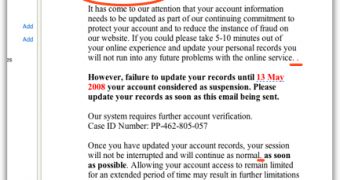Phishing scams occur every once in a while and users have started to get used to them; nevertheless, there are some cases when such an attack may prove to be pretty dangerous. The most recently reported PayPal phishing scam attempts to steal PayPal credentials by using the same traditional method: an email message that informs users that their account information must be updated, the provided link redirecting them to a fake website asking for the mentioned data. Since a lot of users have received the phishing email, Ryan K., Community Manager of Yahoo Mail, came up front and revealed some of the tricky elements of the scam, which could keep you on the safe side.
Even if the email message includes the official PayPal logo, which is actually an old trick used by phishers, you're advised to go further and analyze the message deeper if you're still in doubt if it's a fake or not. "The greeting gives it all away. PayPal will ALWAYS address you formally by the name registered to your account. So if you have a personal account it will be your name, and if you have a business account it will reference your business name," the Yahoo official explained.
"Once you get past the greeting, you can also look for mistakes in the copy. There is an extra period at the end of a paragraph. In the other sample there is a missing return space between paragraphs. These are small things, but a lot of scammers seem to miss them," he added.
These are common elements that could be seen in most phishing attacks launched these days and, even if phishers seem to migrate to more advanced techniques, there are still a number of methods to check the credibility of a suspicious email that arrives in your inbox.

 14 DAY TRIAL //
14 DAY TRIAL //